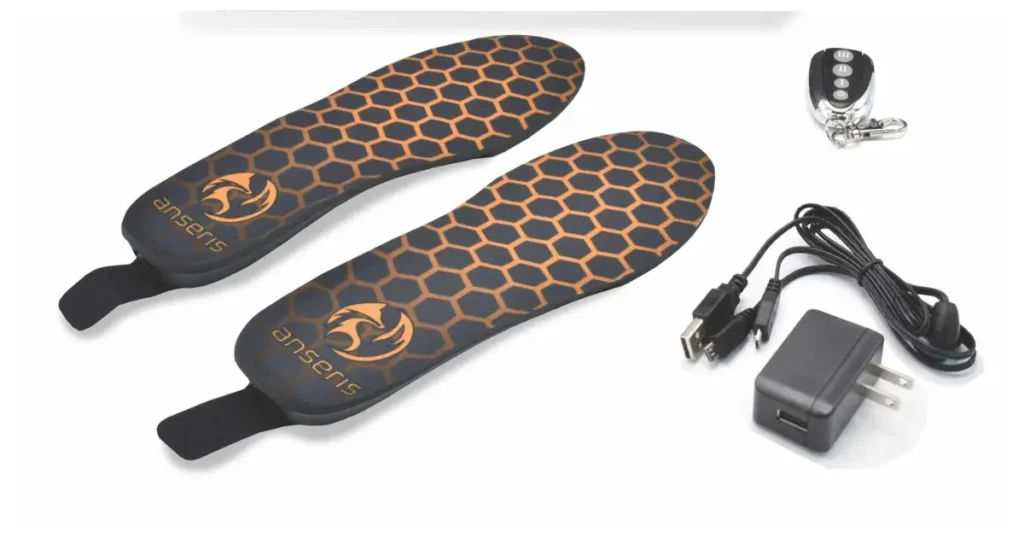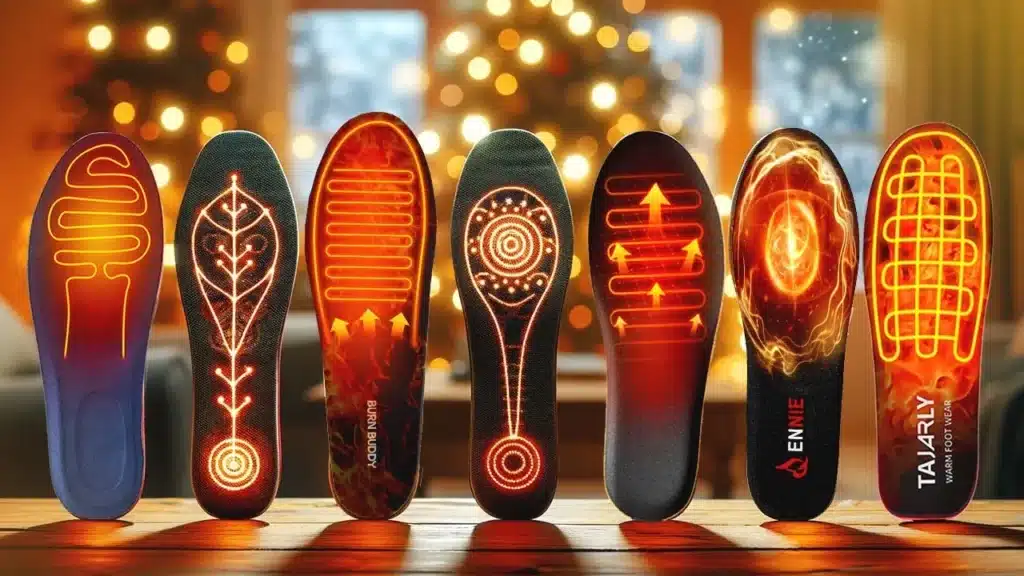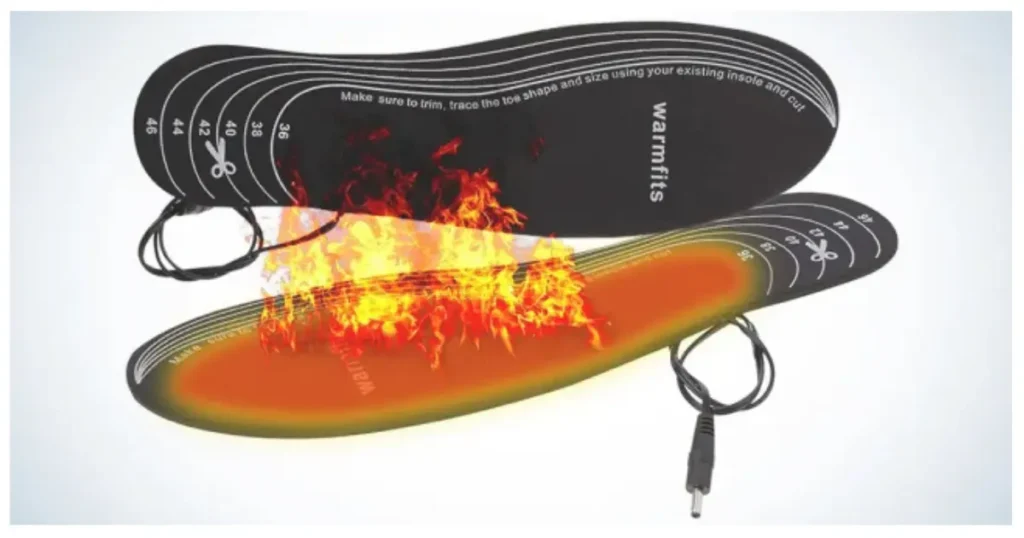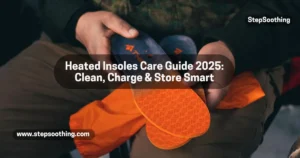Have you ever stepped outside on a freezing winter morning and felt the chill creep in through your shoes, numbing your toes within minutes? If you’ve hiked snow-covered trails, worked in unheated warehouses, or simply waited too long for a bus in winter, you know the frustration of cold feet. It’s more than discomfort—it can lead to stiffness, reduced circulation, and even frostbite. Traditional solutions like thick socks or disposable toe warmers often fall short, either lacking effectiveness or being too bulky or wasteful.
The problem is simple but serious: our feet are often the first part of the body to feel the cold and the hardest to keep warm—especially in active or outdoor settings. For individuals with medical conditions like Raynaud’s disease or poor blood circulation, the stakes are even higher. Cold feet can worsen symptoms, impair mobility, and lower the quality of life during colder months.
But here’s the good news: technology has stepped in with a smart, stylish, and science-backed solution—heated insoles. These high-tech footbeds don’t just cushion your steps—they gently radiate warmth across your feet, keeping you comfortable, active, and protected from cold-related ailments. In this guide, we’ll explore what heated insoles are, how they work, and why they’re becoming a must-have winter essential for everyone—from daily commuters to mountain trekkers. Whether you’re fighting off frostbite or just trying to make your winter commute bearable, heated insoles may be the game-changer your feet have been waiting for.
How Heated Insoles Work: The Technology Behind Toasty Toes

What Are Heated Insoles
Heated insoles are specialized footbeds equipped with miniature heating systems designed to keep your feet warm in cold weather. Unlike regular insoles that only provide cushioning or arch support, these advanced inserts include thin heating elements—often made from carbon fiber or alloy wiring—that distribute gentle, radiant heat across the bottom of the foot. They are especially useful for people who spend long hours outdoors or in unheated environments where maintaining warmth is essential for comfort and safety.
These insoles are powered by small batteries, usually rechargeable lithium-ion units, that supply energy to the heating elements. The warmth they generate is not just for comfort—it can play a critical role in preserving blood circulation and preventing cold-related injuries like frostbite. Because they are designed to fit seamlessly inside winter boots, hiking shoes, or even work boots, heated insoles are a practical investment for anyone exposed to low temperatures, from mountain adventurers to warehouse employees. Furthermore, heated insoles serve a diverse demographic. They cater not only to outdoor enthusiasts but also to people with chronic conditions such as Raynaud’s disease or poor circulation. With options available in both wired and wireless designs, as well as disposable or eco-friendly rechargeable models, these insoles are a modern solution to an age-old winter discomfort—cold feet.

How Do Heated Insoles Work?
Power Source
Heated insoles operate through an integrated system combining power, heat generation, and user control. The energy source is typically a lithium-ion battery, chosen for its compact size and long-lasting charge. Depending on the model, the battery may be housed inside the insole itself or externally attached near the ankle. Most modern versions are USB-rechargeable, taking between two to four hours for a full charge. This level of convenience makes them user-friendly, even for those who are not tech-savvy.
Heating Technology
The heating mechanism itself often relies on carbon fiber or metal alloy filaments. These materials are chosen for their efficient heat conductivity and durability under pressure. Once powered on, the elements release infrared heat that penetrates the surface of the foot evenly, maintaining a stable warmth that does not cause burns or overheating. Some advanced insoles offer zone-specific heating—like targeting just the toes or the entire footbed—giving users customizable warmth based on their needs.
Temperature Control
Temperature control is an essential feature that sets heated insoles apart from passive alternatives. Users can choose between multiple settings (low, medium, high) using manual switches, wireless remotes, or Bluetooth-enabled mobile apps. These controls ensure that the user maintains their preferred level of heat, whether they’re hiking through snow, commuting to work, or standing still on a freezing construction site.
Typical temperature range:
- Low: 35°C (95°F)
- Medium: 45°C (113°F)
- High: 55°C (131°F)
Battery Life
Battery performance depends on heat setting and battery capacity. Common usage times:
- Low heat: 6–8 hours
- Medium heat: 4–6 hours
- High heat: 2–4 hours
Types of Heated Insoles
There are several types of heated insoles on the market, each designed with unique features to suit different lifestyles and footwear. Wireless heated insoles are the most popular due to their all-in-one design that conceals the battery inside the insole itself. This makes them ideal for everyday use, especially in situations where freedom of movement is crucial. On the other hand, wired models feature external battery packs that provide extended battery life, making them perfect for long work shifts in extremely cold environments.
Toe warmers are a targeted option that provide heat only to the front section of the insole. These are especially useful for individuals whose toes are more susceptible to cold, such as people with circulation issues or those who remain stationary outdoors for long periods. For broader coverage, full-length heated insoles distribute heat evenly across the entire footbed. These are favored by athletes, hikers, and outdoor workers who require all-over warmth and comfort throughout the foot.
In terms of reusability, there are both rechargeable and disposable options. Rechargeable insoles are eco-friendly and more cost-effective in the long term, as they can be used repeatedly over several winters. Disposable models, on the other hand, are typically air-activated and best suited for emergency use or short-term travel. When choosing the right type, consumers should consider not only their activity level but also the kind of footwear they’ll be using and the environmental conditions they’ll face.
| Type | Features | Best For |
| Wireless | No external wires, integrated battery | General everyday use |
| Wired | External battery pack with long runtime | Work boots, cold conditions |
| Toe Warmers | Heat limited to toes only | Targeted heating |
| Full-Length | Heat distributed across entire footbed | Maximum warmth and comfort |
| Rechargeable | USB-charged, reusable, eco-friendly | Long-term users |
| Disposable | One-time use, air-activated | Emergencies or travel |
Top brands include Thermacell, Lenz, Hotronic, and ActionHeat.

Benefits and Use Cases
Heated insoles are not just a luxury for cold days—they provide tangible health and performance benefits. One of their primary advantages is the prevention of cold-related injuries such as frostbite, which can occur after prolonged exposure to freezing temperatures. The consistent warmth also helps in maintaining proper blood circulation, which is especially important for people with Raynaud’s syndrome or other vascular issues. Keeping the feet warm helps prevent the narrowing of blood vessels, reducing pain and numbness.
Beyond medical advantages, heated insoles can significantly enhance comfort and endurance during physical activity. Cold muscles and joints are more prone to stiffness and injury, so keeping the feet warm supports better movement and flexibility, which is critical for athletes, hikers, and workers alike. Additionally, they reduce the distraction and discomfort of cold feet, allowing users to focus more on their tasks or enjoy outdoor activities longer.
These insoles are beneficial across a variety of use cases. For example, elderly individuals often struggle with circulation and benefit greatly from the additional warmth. Hunters, photographers, and surveillance professionals who remain still in freezing environments also rely on heated insoles for sustained comfort. Similarly, workers in refrigerated warehouses, cold storage facilities, and outdoor construction sites find heated insoles to be an essential part of their daily gear.
Heated insoles serve both medical and comfort purposes:
- Prevent cold-related injuries like frostbite
- Improve circulation for people with Raynaud’s disease
- Relieve foot pain in cold, damp environments
- Support athletic performance by maintaining muscle flexibility
- Enhance comfort during outdoor recreation or commuting
They are especially useful for:
- Elderly individuals with poor blood flow
- Hunters or photographers standing still outdoors
- Workers in cold storage or construction
Disadvantages and Limitations
While heated insoles offer impressive benefits, there are a few drawbacks to consider. The cost is a major factor, with most quality pairs priced between $80 and $250. For some users, this may seem steep, especially when comparing them to traditional wool insoles or basic thermal socks. However, the cost reflects the advanced technology and components involved in creating safe and effective heating systems for footwear.
Another limitation is the battery life, which requires proactive management. On higher heat settings, batteries may only last a few hours, which can be a problem during long treks or workdays unless a backup power source is available. Additionally, fit compatibility is another concern—heated insoles can be bulky, making them unsuitable for certain types of shoes, such as slim dress boots or tight sneakers.
Maintenance and environmental exposure are also considerations. Users must regularly clean and charge their insoles to ensure performance and longevity. While some models are water-resistant, they are not waterproof and can suffer damage if submerged in water. Furthermore, like all electronics, they may be prone to occasional malfunctions, especially when used in wet or rugged conditions. Choosing a reputable brand with a strong warranty can help mitigate these risks.

Buying Guide & Usage Tips
What should you consider before purchasing heated insoles?
When shopping for heated insoles, start by checking size compatibility—they should match your shoe size and fit securely inside your preferred footwear. Next, evaluate the heating coverage: some insoles warm just the toes, while others provide full-foot coverage. Think about the battery life and whether it suits your intended usage time. If you spend extended periods outdoors, opt for models with longer battery durations or interchangeable packs. The temperature control method also matters—choose between manual controls, wireless remotes, or app-based systems depending on your convenience preferences.
How do you get the most out of your heated insoles?
To extend the lifespan and efficiency of your heated insoles, follow a few essential usage tips. Always fully charge the battery before the first use and regularly check for firmware updates if your model uses an app. Before heading out, test the fit and ensure the insoles are securely positioned within your footwear to prevent slippage or discomfort. After use, allow them to cool and then store them in a cool, dry place. Avoid excessive heat, water, or dirt exposure.
Cleaning and maintenance best practices
Never place heated insoles in a washing machine or submerge them in water. Instead, wipe them down with a slightly damp cloth to remove dirt or sweat, making sure not to wet the battery compartment. Periodic cleaning prevents odor buildup and helps preserve material integrity. If storing for long periods, disconnect removable batteries and keep them in a moisture-free environment to avoid corrosion. Following these maintenance habits ensures consistent performance and safety.
Heated Insoles vs. Alternatives
How do heated insoles compare to other warming solutions?
Heated insoles offer active, customizable warmth, setting them apart from passive alternatives like thermal insoles or wool socks. Unlike chemical toe warmers that provide one-time, short-duration heat, heated insoles are rechargeable and reusable, making them more eco-friendly and cost-effective in the long run. Their ability to maintain a consistent temperature through digital or manual controls allows for better user experience and adaptability to changing conditions.
What about heated socks and toe warmers?
Heated socks cover the entire foot and ankle, delivering more comprehensive warmth, especially in sub-zero conditions. However, they tend to be bulkier and take longer to heat up, which may limit their comfort inside tight-fitting footwear. On the other hand, chemical toe warmers are ultra-portable and inexpensive, making them great for emergencies or travel—but their single-use nature and lack of temperature control make them less sustainable or versatile.
Thermal insoles as a passive alternative
Thermal or insulating insoles, often made from wool or reflective materials, are great for retaining existing heat but lack the ability to generate warmth actively. They are best used in moderately cold conditions or paired with other gear. While these passive options are lightweight and maintenance-free, they don’t offer the same level of comfort or performance as heated insoles during extreme cold or long exposure.
| Option | Pros | Cons |
| Heated Insoles | Customizable, rechargeable, reusable | Price, battery maintenance |
| Heated Socks | Covers entire foot and ankle | Bulkier, slower heat-up |
| Chemical Toe Warmers | Cheap, portable | Disposable, short lifespan |
| Thermal Insoles | Passive insulation | No active heating |
Innovations in Heated Insole Technology
The world of heated insoles is rapidly advancing thanks to innovations in smartwear technology and eco-conscious design. One of the most significant breakthroughs is Bluetooth integration, which allows users to control heat levels remotely via smartphone apps. This not only adds convenience but also enables real-time adjustments based on activity level or temperature changes. Some advanced models are equipped with sensors that automatically regulate heat output according to ambient conditions, ensuring consistent warmth without manual input.
Battery technology is also evolving. New insoles feature flexible battery cells that conform to foot contours, improving comfort while reducing bulk. These next-gen batteries offer faster charging, longer life cycles, and greater energy efficiency. Additionally, companies are investing in eco-friendly materials, such as recyclable insoles and biodegradable packaging, to reduce their environmental footprint without compromising performance.
Another emerging trend is the use of AI and machine learning to track usage patterns and adapt heat settings based on individual user behavior. For example, insoles can learn your daily routine and automatically adjust temperature before you step outside. As these innovations continue to roll out, heated insoles are transitioning from niche gear to mainstream winter essentials, offering unmatched personalization and performance.
People Also Asked
Are heated insoles safe?
Yes, when purchased from reputable brands, heated insoles are extremely safe. Most models come equipped with built-in safety features such as automatic shut-off mechanisms and temperature limiters to prevent overheating. The heating elements are designed to emit low-level infrared warmth, which gently radiates heat without causing skin irritation or burns. As long as users follow the manufacturer’s instructions, heated insoles pose minimal risk and are considered safe for daily use, even in high-activity settings.
Are they waterproof?
Most high-quality heated insoles are water-resistant, meaning they can handle light moisture, snow, or splashes. However, they are generally not fully waterproof, and submerging them in water can damage the electronic components and compromise battery safety. Users should avoid wearing them in environments where complete water exposure is likely, such as during heavy rain or stream crossings. Choosing insoles with sealed battery housings and moisture-resistant materials can help improve durability in damp conditions.Some models are water-resistant, but not fully waterproof. They shouldn’t be submerged in water.
Can I walk or run with heated insoles?
Absolutely. Heated insoles are designed to be flexible and durable, supporting a wide range of motion. Whether you’re walking to work, hiking a snowy trail, or even running short distances, they can handle moderate to active use. It’s important to ensure that the insoles fit properly inside your footwear to avoid discomfort or shifting while in motion. Many advanced models are made from lightweight materials that contour to your feet, providing both warmth and shock absorption without hindering mobility.Yes. High-quality insoles are flexible and designed to support walking, hiking, and even running.
How long do they last?
Most rechargeable models last up to 500 charge cycles, which translates to 2–4 years of regular use.



